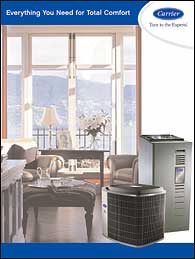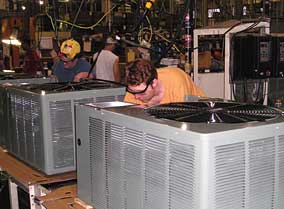
Preparing for the Jan. 23, 2006, deadline to implement the 13 SEER requirement imposed by the Department of Energy (DOE) goes far beyond the factory floor. It's a mind game.
In the eyes of air conditioning manufacturers, distributors, contractors, and consumers need to know what the new efficiency level means and how it will impact their operations and the indoor comfort it can deliver. Unless they do, the entire industry may suffer, they believe.
Few manufacturers seem to want a competition where the only consideration of whose 13-SEER (or higher) air conditioning system will be price, or where contractors will sell and consumers will choose bare-bone units that deliver far less real benefit than they could.
‘The primary communications challenge is to provide HVAC contractors with clear and simple marketing tools that effectively explain to end users the benefits and advantages of more efficient home comfort systems," said Ed Raniszeski, director, Market Development and Communications, Rheem Air Conditioning Division (Fort Smith, Ark.) "Those of us who have increasingly endorsed the Energy Star mantra now have a golden opportunity to make greater efficiency a broad-based reality. Our marketing support materials will be dedicated to helping shoppers understand the greater value in energy savings, environmental impact, indoor health, and increased comfort deliverables gained from 13 SEER and higher systems."

13 Is The Lucky Number
Carrier Corp. (Syracuse, N.Y.) and its corporate-owned brands, including Bryant and ICP, are investing heavily in contractor education and training, noted Halsey Cook, president, Residential Division."We want to help our customers educate homeowners about the benefits of higher efficiencies - understanding the paybacks. The higher price points associated with 13 SEER are something that consumers will have to be educated about," said Cook.
The concept of total, integrated systems will be one focus of the Carrier effort.
"Contractors will have to ensure that the benefit they present to consumers is, in fact, a true 13-SEER system," stressed Cook.
For the replacement market, "If someone just changes the condensing unit on the slab, something that says 13 SEER, you may still have a 10-SEER fancoil on the inside," he said.
Offering incentives for both consumers and contractors to do the right thing and change out the entire system is very important, Cook believed.
Dave Pannier, president, Residential Systems, Trane and American Standard (Tyler, Texas), sees the move to a minimum 13 SEER as a challenge for the industry to educate consumers on the benefits of higher system efficiencies and the choices they will have. (See "What Does the Future Hold?" May 3, The News.) Pannier is also 2004 chairman of the board of the Air Conditioning and Refrigeration Institute (ARI).
To offset initial upfront costs of equipment that is 13 SEER or higher, "contractors will need to focus their message on value, system features, winter operational savings, humidity controls, and quiet operation," suggested Bill Hanesworth, vice president, sales, Rheem Air Conditioning Division.
While Hanesworth acknowledges that the minimum standard will continue to dominate in 2006 with the exception of 13 SEER replacing 10, Raniszeski said, "We believe that it is in the best economic and social interest of every small business and homeowner to purchase the most efficient HVAC system they can afford, and we believe that that is the most important communications goal of our marketing materials."
Ed Dooley, vice president, communications and education, ARI, suggested the investment in 13 or higher SEER equipment can be best sold by pointing out that consumers will realize not just lower operating costs, but also better comfort by incorporating elements such as humidification control, better air filtering, and perhaps zoning.
"You can sell up the whole system to provide better indoor air quality for the consumer. They spend 90 percent of their time indoors, and most of that in their home, so why not be comfortable? With that message, if you have the right equipment, you can really make a good indoor air quality argument," said Dooley.

New Approach Needed
According to Thomas F. Huntington, president, York International Corp., Unitary Products Group (Norman, Okla.), the 13-SEER standard "poses challenges for contractors who are following the traditional sales approach, where the ‘good/better/best' story is 10, 12, and 14 SEER."In a recent position paper, Huntington wrote, "Contractors have focused on ROI [return on investment] at the various SEER levels, encouraged by manufacturers who provided hip-pocket tools for payback calculations ... Now, as the minimum SEER is raised,
we arrive at a technical and marketing crossroads. Unit cost will increase exponentially for equipment above 13 SEER (for example, two-stage compressor capability is needed above 14 SEER). This deflates the traditional ROI/payback sales pitch, as fewer homeowners will secure significant payback on energy efficiency."
The industry has a choice of either commoditizing the product "or we learn to sell prescriptive solutions to IAQ and comfort," Huntington stated. "This is where we manufacturers must participate and support our dealers."
York will introduce such support in a dealer "boot camp" series on selling value, and express that message through various training and communications programs, he said.
Doug Widenmann, York UPG senior director of marketing, said, "Real progressive dealers are going to move to more indoor air quality products, more zoning, more advanced controls and services to differentiate their offerings."
"I think it's very short-sighted of this industry to consider selling on efficiency alone," added Doug Young, vice president and general manager, Lennox Residential. "In fact, the consumers out there aren't buying efficiency. Hopefully they're buying either to replace an existing unit or adding on to their system or otherwise enhance their comfort.
"From our standpoint, we think that makes all the sense in the world. In fact, I had a very good conversation with friends over at the ACCA [Air Conditioning Contractors of America] headquarters not long ago, and they talked about the need for contractors throughout the U.S. to focus on things other than efficiency so that we don't let ourselves fall prey to selling on efficiency alone."
Young and others seem to agree that selling by efficiency numbers alone is selling the industry - and consumers - short, but by teaming up the soon-required higher efficiencies with a total indoor comfort approach, manufacturers, contractors, and consumers can all benefit.
Next installment: Find out how contractors themselves view the impact and potential of the minimum 13 SEER standard on their businesses.
Norland is a freelance writer from Langley, S.C. He can be reached at jimnorland@aol.com.
Publication date: 08/09/2004

Report Abusive Comment